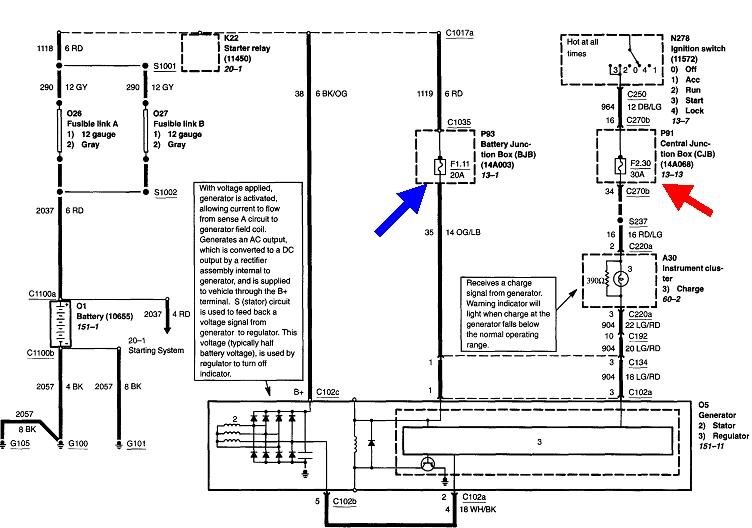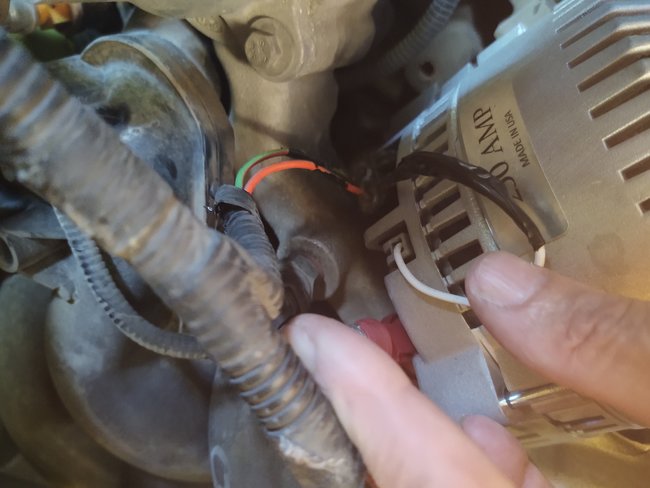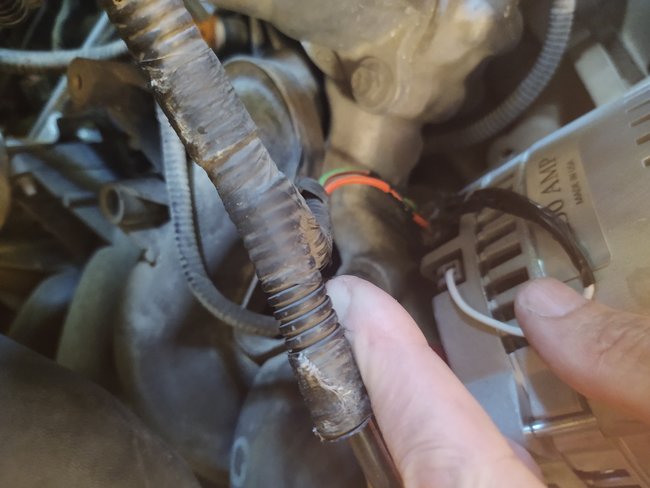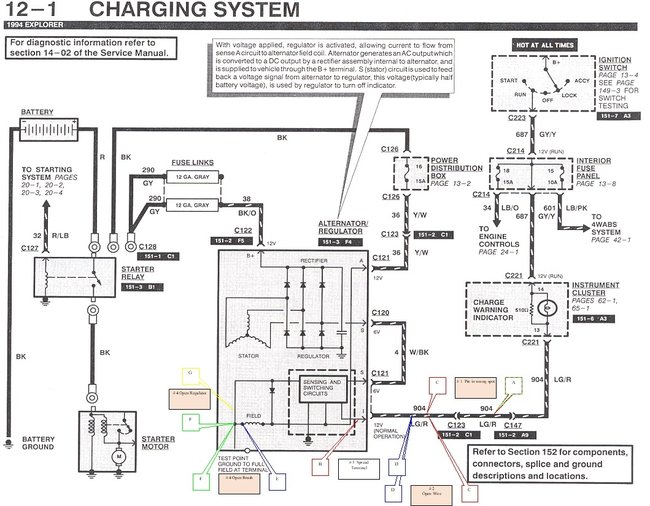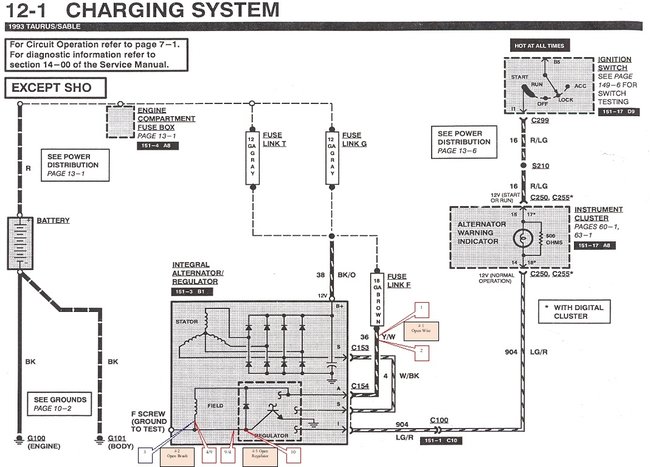I'm waiting for my access to online service manuals to be fixed. Until then, I can share that the white wire you have your thumb on, (dandy photos, by the way), comes from within the generator and goes right back into it on that three-wire plug. That is mainly a Ford thing going back to the mid '60s. When the charging system is working, that wire taps off part of the output circuitry and will have exactly half of system voltage on it, or roughly 7 volts. That is the voltage that tells the voltage regulator the system is working and for it to turn off the warning light on the dash, when you have that. You can also use that as a test to see if the charging system is working.
This diagram is for a '94 Explorer, but it should be similar to yours. In later years another unnecessary computer circuit was added to the system. I'll have to wait to see if that applies to your model, but I think this diagram is accurate. Don't pay attention to the callouts I added. Those are for the "bugged" cars I built for my students to diagnose. They show a white / black wire for the white wire you have.
The bottom wire, (shown here as light green / red), is for the dash light. If you see the dash light turn on when the ignition switch is turned on, that circuit is working. It still works if the bulb is burned out as there is a resistor across the bulb for that purpose. Since you have a gauge instead, that circuit is still there, but it just uses that resistor. They show it here as a 510 ohm resistor. Regardless, current flow through that circuit is what tells the voltage regulator to wake up and start doing its thing. At this time you will find very close to 2.0 volts on that green / red wire at the generator, leaving roughly 10 volts to run the bulb, and / or be dropped across the 510 ohm resistor.
Once the regulator sees the charging system is working, (by that 7 volts on the white wire), it puts full system voltage back out on the light green / red wire. With full voltage there, and full voltage on the other side of the bulb from the battery / ignition switch, the difference is 0.0 volts, so the bulb turns off. At this time you will measure full system voltage on the light green / red wire. If you still have around 2.0 volts with the engine running, the charging system is not working properly. In older systems the regulator turned the warning bulb on for a no-charge condition. Beginning around the late '80s or early '90s with this system, the regulator also turns the warning light on for an under-charge and an over-charge condition. In those last two conditions, you'll be able to drive longer, but an over-charge condition can damage the battery.
For all of this to work, the system is powered through the yellow / white wire shown at the top of the generator, right side, and it has a tiny "12V" notation under it. That one must have full system voltage at all times. You'll find battery voltage of 12.6 volts with the engine off, and typically 13.75 to 14.75 volts with the engine running. This circuit is the source of a real lot of failure-to-charge problems including after the generator has been replaced. I mentioned earlier that the fuse often blows for no particular reason. I added the second diagram because I noticed in this '94 Taurus, they did away with that fuse in favor of a fuse link wire. Those are a regular wire, but of a smaller diameter making them the weal link in the chain. The insulation is designed to not burn or melt. They take some time to burn open, so they act like a slow-blow fuse. In the 2002 diagram I have on file, they again show a fuse, so now I don't know yet which you have. You didn't find a fuse listed in the under-hood fuse box, and they don't show or list fuse link wires. Regardless, you gotta have 12 volts on that wire. Even if you aren't sure of wire colors or their order in the plug, just measure the voltages on all three with the ignition switch turned off. Two are going to have 0.0 volts and that yellow / white one must have 12.6 volts.
To make this more complicated than necessary, if you don't find that 12 volts on one wire in the plug, unplug it, then carefully measure directly on the terminals. You can't help but insure you're making a good connection with the probe that way. There is one major pitfall to be aware of when doing this. Okay, two things to be aware of. First, don't stuff the probe into a terminal as that can spread it to the point is no longer makes good contact. The more important second point only applies if you have a fuse link wire, not a regular fuse. When fuse link wires burn open, they leave behind a carbon track inside the insulation where arcing occurred. That carbon can conduct enough current for a digital voltmeter to falsely see it as 12.6 volts. That makes it appear the fuse wire is okay. A test light is much more accurate for this type of test because it requires current flow to work, and there's no way any substantial current can get through that carbon track. The test light will correctly show 0 volts.
This is why it is usually only valid when taking voltage readings when it is done with the plug connected. In this case the voltage regulator will be trying to power up from that yellow / white wire, but all of the 12.6 volts will be dropped across the carbon track. That leaves 0 volts to be seen by the voltmeter at the plug.
It occurs to me I overlooked one test. Since you don't have a dash warning light, you don't have that visual indication that circuit is working. Measure the voltage on the light green / red wire. When you have a dash light, the easiest and fastest is to unplug that connector, then test with a test light on all three wires, especially when the colors might be different due to the plug was replaced or my diagram has different colors. You still have that yellow / white wire with 12.6 volts. The white wire is going to have 0 volts. The last one should have a dim test light. Half of the 12.6 volts is dropped across the dash bulb, leaving the other 6 volts to be dropped across the test light's bulb. This assumes you're using a standard test light, not one of the new fancy ones with all kinds of circuitry inside.
This doesn't work when you have only a dash gauge. That's because the 510 ohm resistor is so large, electrically, that it drops almost all of the 12.6 volts leaving nothing to be measured on the light green, red wire. Instead, for this test, leave the plug connected, then back-probe that wire through the back of the plug, with the voltmeter. Expect to see something, but it will be real low. If you aren't sure, now unplug the connector, then read that voltage again. Now you should see the full 12.6 volts.
If the voltage is missing on the light green / red wire, the rest of the system might be okay, but the voltage regulator is not getting the signal to tell it to turn on and start running the generator. Sometimes, due to residual magnetism, the system can self-start on its own, typically when engine speed is raised substantially. As an alternative, you can apply 12 volts to that wire to take the place of the dash circuit. A fast way to do that is to use the test light to act as the dash light. Connect its lead to the battery positive terminal. To verify this works, you're testing for ground now, so it will light up when you touch the probe to the engine block or body sheet metal. Touch the probe to the light green / red wire while the engine is running. You only have to do that for an instant. Once the regulator turns on, it will continue running the generator until the engine stops rotating.
Images (Click to make bigger)
Wednesday, June 30th, 2021 AT 7:45 PM

